- Home
- Richard Dawkins
The Blind Watchmaker Page 36
The Blind Watchmaker Read online
Page 36
This is a convenient moment to deal with the hypothesis of species selection, which is left over, in a sense, from the previous chapter. I shan’t spend very much time on it, as I have spelled out in The Extended Phenotype my doubts about its alleged importance in evolution. It is true that the vast majority of species that have ever lived have gone extinct. It is also true that new species come into existence at a rate that at least balances the extinction rate, so that there is a kind of ‘species pool’ whose composition is changing all the time. Nonrandom recruitment to the species pool and nonrandom removal of species from it could, it is true, theoretically constitute a kind of higher-level natural selection. It is possible that certain characteristics of species bias their probability of going extinct, or of budding off new species. The species that we see in the world will tend to have whatever it takes to come into the world in the first place — to ‘be speciated’ — and whatever it takes not to go extinct. You can call that a form of natural selection if you wish, although I suspect that it is closer to single-step selection than to cumulative selection. What I am sceptical about is the suggestion that this kind of selection has any great importance in explaining evolution.
This may just reflect my biased view of what is important. As I said at the beginning of this chapter, what I mainly want a theory of evolution to do is explain complex, well-designed mechanisms like hearts, hands, eyes and echolocation. Nobody, not even the most ardent species selectionist, thinks that species selection can do this. Some people do think that species selection can explain certain longterm trends in the fossil record, such as the rather commonly observed trend towards larger body size as the ages go by. Modern horses, as we have seen, are bigger than their ancestors of 30 million years ago. Species selectionists object to the idea that this came about through consistent individual advantage: they don’t see the fossil trend as indicating that large individual horses were consistently more successful than small individual horses within their species. What they think happened is this. There were lots of species, a species pool. In some of these species, average body size was large, in others it was small (perhaps because in some species large individuals did best, in other species small individuals did best). The species with large body size were less likely to go extinct (or more likely to bud off new species like themselves) than the species with small body size. Whatever went on within species, according to the species selectionist, the fossil trend towards larger body size was due to a succession of species with progressively larger average body size. It is even possible that in the majority of species smaller individuals were favoured, yet the fossil trend could still be towards larger body size. In other words the selection of species could favour that minority of species in which larger individuals were favoured. Exactly this point was made, admittedly in a spirit of devil’s advocacy, by the great neo-Darwinian theorist George C. Williams, long before modern species selectionism came on the scene.
It could be said that we have here, and maybe in all alleged examples of species selection, not so much an evolutionary trend, more a successional trend, like the trend towards larger and larger plants as a piece of waste ground becomes colonized successively by small weeds, larger herbs, shrubs and, finally, the mature ‘climax’ forest trees. Anyway, whether you call it a successional trend or an evolutionary trend, the species selectionists may well be right to believe that it is this kind of trend that they, as palaeontologists, are often dealing with in successive strata of the fossil record. But, as I said, nobody wants to say that species selection is an important explanation for the evolution of complex adaptations. Here is why.
Complex adaptations are in most cases not properties of species, they are properties of individuals. Species don’t have eyes and hearts; the individuals in them do. If a species goes extinct because of poor eyesight, this presumably means that every individual in that species died because of poor eyesight. Quality of eyesight is a property of individual animals. What kinds of traits can species be said to have? The answer must be traits that affect the survival and reproduction of the species, in ways that cannot be reduced to the sum of their effects on individual survival and reproduction. In the hypothetical example of the horses, I suggested that that minority of species in which larger individuals were favoured were less likely to go extinct than the majority of species in which smaller individuals were favoured. But this is pretty unconvincing. It is hard to think of reasons why species survivability should be decoupled from the sum of the survivabilities of the individual members of the species.
A better example of a species level trait is the following hypothetical one. Suppose that in some species all individuals make their living in the same way. All koalas, for instance, live in eucalyptus trees and eat only eucalyptus leaves. Species like this can be called uniform. Another species might contain a diversity of individuals that make their living in different ways. Each individual could be just as specialized as an individual koala, but the species as a whole contains a variety of dietary habits. Some members of the species eat nothing but eucalyptus leaves; others nothing but wheat; others nothing but yams; others nothing but lime peel, and so on. Call this second kind of species variegated species. Now I think it is easy to imagine circumstances in which uniform species would be more likely to go extinct than variegated species. Koalas rely totally on a supply of eucalyptus, and a eucalyptus plague analogous to Dutch elm disease would finish them. In the variegated species, on the other hand, some members of the species would survive any particular plague of food plants, and the species could go on. It is also easy to believe that variegated species are more likely to bud off new, daughter species than uniform species. Here, perhaps, would be examples of true species-level selection. Unlike shortsightedness or long-leggedness, ‘uniformness’ and ‘variegatedness’ are true species-level traits. The trouble is that examples of such species-level traits are few and far between.
There is an interesting theory by the American evolutionist Egbert Leigh which can be interpreted as a possible candidate example of true species-level selection, although it was suggested before the phrase ‘species selection’ came into vogue. Leigh was interested in that perennial problem, the evolution of ‘altruistic’ behaviour in individuals. He correctly recognized that if individual interests conflict with those of the species, the individual interests — short-term interests — must prevail. Nothing, it seems, can prevent the march of selfish genes. But Leigh made the following interesting suggestion. There must be some groups or species in which, as it happens, what is best for the individual pretty much coincides with what is best for the species. And there must be other species in which the interests of the individual happen to depart especially strongly from the interests of the species. Other things being equal, the second type of species could well be more likely to go extinct. A form of species selection, then, could favour, not individual self-sacrifice, but those species in which individuals are not asked to sacrifice their own welfare. We could then see apparently unselfish individual behaviour evolving, because species selection has favoured those species in which individual self-interest is best served by their own apparent altruism.
Perhaps the most dramatic example of a truly species-level trait concerns the mode of reproduction, sexual versus asexual. For reasons that I haven’t the space to go into, the existence of sexual reproduction poses a big theoretical puzzle for Darwinians. Many years ago R. A. Fisher, usually hostile to any idea of selection at levels higher than the individual organism, was prepared to make an exception for the special case of sexuality itself. Sexually reproducing species, he argued, for reasons that, again, I shan’t go into (they aren’t as obvious as one might think), are capable of evolving faster than asexually reproducing species. Evolving is something that species do, not something that individual organisms do: you can’t talk of an organism as evolving. Fisher was suggesting, then, that species-level selection is partly responsible for the fact that sexual reproduction is so common among modern an
imals. But, if so, we are dealing with a case of single-step selection, not cumulative selection.
Asexual species when they occur tend, according to the argument, to go extinct because they don’t evolve fast enough to keep up with the changing environment. Sexual species tend not to go extinct, because they can evolve fast enough to keep up. So what we see around us are mostly sexual species. But the ‘evolution’ whose rate varies between the two systems is, of course, ordinary Darwinian evolution by cumulative selection at the individual level. The species selection, such as it is, is simple single-step selection, chosing between only two traits, asexuality versus sexuality, slow evolution versus fast evolution. The machinery of sexuality, sex organs, sexual behaviour, the cellular machinery of sexual cell division, all these must have been put together by standard, low-level Darwinian cumulative selection, not by species selection. In any case, as it happens, the modern consensus is against the old theory that sexuality is maintained by some kind of group level or species level selection.
To conclude the discussion of species selection, it could account for the pattern of species existing in the world at any particular time. It follows that it could also account for changing patterns of species as geological ages give way to later ages, that is, for changing patterns in the fossil record. But it is not a significant force in the evolution of the complex machinery of life. The most it can do is to choose between various alternative complex machineries, given that those complex machineries have already been put together by true Darwinian selection. As I have put it before, species selection may occur but it doesn’t seem to do anything much! I now return to the subject of taxonomy and its methods.
I said that cladistic taxonomy has the advantage over librarians’ types of taxonomy that there is one unique, true hierarchical nesting pattern in nature, waiting to be discovered. All that we have to do is develop methods of discovering it. Unfortunately there are practical difficulties. The most interesting bugbear of the taxonomist is evolutionary convergence. This is such an important phenomenon that I have already devoted half a chapter to it. In Chapter 4 we saw how, over and over again, animals have been found to resemble unrelated animals in other parts of the world, because they have similar ways of life. New World army ants resemble Old World driver ants. Uncanny resemblances have evolved between the quite unrelated electric fish of Africa and South America; and between true wolves and the marsupial ‘wolf’ Thylacinus of Tasmania. In all these cases I simply asserted without justification that these resemblances were convergent: that they had evolved independently in unrelated animals. But how do we know that they are unrelated? If taxonomists use resemblances to measure closeness of cousinship, why weren’t taxonomists fooled by the uncannily close resemblances that seem to unite these pairs of animals? Or, to twist the question round into a more worrying form, when taxonomists tell us that two animals really are closely related — say rabbits and hares — how do we know that the taxonomists haven’t been fooled by massive convergence?
This question really is worrying, because the history of taxonomy is replete with cases where later taxonomists have declared their predecessors wrong for precisely this reason. In Chapter 4 we saw that an Argentinian taxonomist had pronounced the litopterns ancestral to true horses, whereas they are now thought to be convergent on true horses. The African porcupine was long believed to be closely related to the American porcupines, but the two groups are now thought to have evolved their prickly coats independently. Presumably prickles were useful to both for similar reasons in the two continents. Who is to say that future generations of taxonomists won’t change their minds yet again? What confidence can we vest in taxonomy, if convergent evolution is such a powerful faker of deceptive resemblances? The main reason why I personally feel optimistic is the arrival on the scene of powerful new techniques based on molecular biology.
To recapitulate from earlier chapters, all animals and plants and bacteria, however different they appear to be from one another, are astonishingly uniform when we get down to molecular basics. This is most dramatically seen in the genetic code itself. The genetic dictionary has 64 DNA words of three letters each. Every one of these words has a precise translation into protein language (either a particular amino acid or a punctuation mark). The language appears to be arbitrary in the same sense as a human language is arbitrary (there is nothing intrinsic in the sound of the word ‘house’, for instance, which suggests to the listener any attribute of a dwelling). Given this, it is a fact of great significance that every living thing, no matter how different from others in external appearance it may be, ‘speaks’ almost exactly the same language at the level of the genes. The genetic code is universal. I regard this as near-conclusive proof that all organisms are descended from a single common ancestor. The odds of the same dictionary of arbitrary ‘meanings’ arising twice are almost unimaginably small. As we saw in Chapter 6, there may once have been other organisms that used a different genetic language, but they are no longer with us. All surviving organisms are descended from a single ancestor from which they have inherited a nearly identical, though arbitrary, genetic dictionary, identical in almost every one of its 64 DNA words.
Just think of the impact of this fact on taxonomy. Before the age of molecular biology, zoologists could be confident of the cousinship of only animals that shared a very large number of anatomical features. Molecular biology suddenly opened a new treasure chest of resemblances to add to the meagre list offered by anatomy and embryology. The 64 identities (resemblances is too weak a word) of the shared genetic dictionary is only the start. Taxonomy has been transformed. What were once vague guesses of cousinship have become statistical near-certainties.
The almost complete word-for-word universality of the genetic dictionary is, for the taxonomist, too much of a good thing. Once it has told us that all living things are cousins, it cannot tell us which pairs are closer cousins than others. But other molecular information can, because here we find variable degrees of resemblance rather than total identity. The product of the genetic translating machinery, remember, is protein molecules. Each protein molecule is a sentence, a chain of amino acid words from the dictionary. We can read these sentences, either in their translated protein form or in their original DNA form. Though all livings things share the same dictionary, they don’t all make the same sentences with their shared dictionary. This offers us the opportunity to work out varying degrees of cousinship. The protein sentences, though different in detail, are often similar in overall pattern. For any pair of organisms, we can always find sentences that are sufficiently similar to be obviously slightly ‘garbled’ versions of the same ancestral sentence. We have already seen this in the example of the minor differences between the histone sequences of cows and peas.
Taxonomists can now compare molecular sentences exactly as they might compare skulls or leg bones. Closely similar protein or DNA sentences can be assumed to come from close cousins; more different sentences from more distant cousins. These sentences are all constructed from the universal dictionary of no more than 64 words. The beauty of modern molecular biology is that we can measure the difference between two animals exactly, as the precise number of words by which their versions of a particular sentence differ. In the terms of the genetic hyperspace of Chapter 3, we can measure exactly now many steps separate one animal from another, at least with respect to a particular protein molecule.
An added advantage of using molecular sequences in taxonomy is that, according to one influential school of geneticists, the ‘neutralists’ (we shall meet them again in the next chapter), most of the evolutionary change that goes on at the molecular level is neutral. This means that it is not due to natural selection but is effectively random, and therefore that, except through occasional bad luck, the bugbear of convergence is not there to mislead the taxonomist. A related fact is that, as we have already seen, any one kind of molecule seems to evolve at a roughly constant rate in widely different animal groups. This means that the nu
mber of differences between comparable molecules in two animals, say between human cytochrome and warthog cytochrome is a good measure of the time that has elapsed since their common ancestor lived. We have a pretty accurate ‘molecular clock’. The molecular clock allows us to estimate, not just which pairs of animals have the most recent common ancestors, but also approximately when those common ancestors lived.
The reader may be puzzled, at this point, by an apparent inconsistency. This whole book emphasizes the overriding importance of natural selection. How then can we now emphasize the randomness of evolutionary change at the molecular level? To anticipate Chapter 11, there really is no quarrel with respect to the evolution of adaptations, which are the main subject of this book. Not even the most ardent neutralist thinks that complex working organs like eyes and hands have evolved by random drift. Every sane biologist agrees that these can only have evolved by natural selection. It is just that the neutralists think — rightly, in my opinion — that such adaptations are the tip of the iceberg: probably most evolutionary change, when seen at the molecular level, is non-functional.

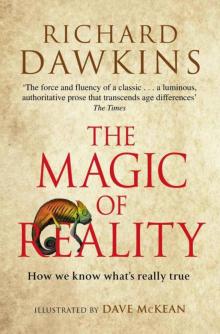 The Magic of Reality
The Magic of Reality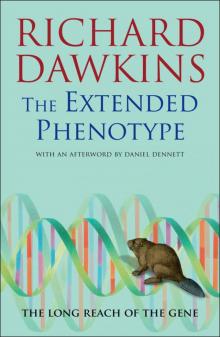 The Extended Phenotype
The Extended Phenotype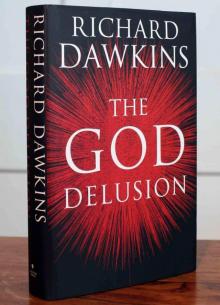 The God Delusion
The God Delusion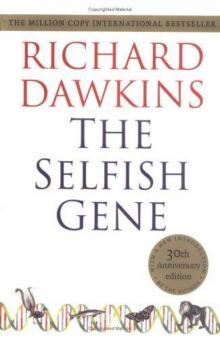 The Selfish Gene
The Selfish Gene The Blind Watchmaker
The Blind Watchmaker The Greatest Show on Earth
The Greatest Show on Earth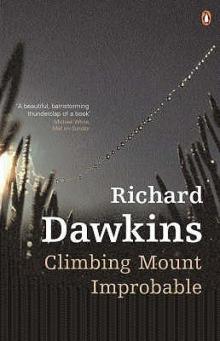 Climbing Mount Improbable
Climbing Mount Improbable Outgrowing God
Outgrowing God Brief Candle in the Dark
Brief Candle in the Dark The Greatest Show on Earth: The Evidence for Evolution
The Greatest Show on Earth: The Evidence for Evolution Science in the Soul
Science in the Soul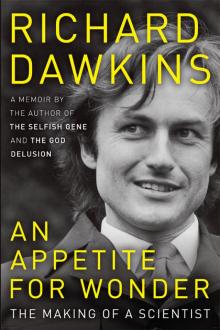 An Appetite for Wonder
An Appetite for Wonder